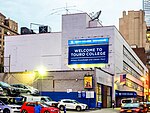Albemarle Hotel
1860 establishments in New York (state)Broadway (Manhattan)Buildings and structures demolished in 1915Defunct hotels in ManhattanDemolished buildings and structures in Manhattan ... and 2 more
Flatiron DistrictSource attribution

Albemarle Hotel (also known as Albemarle House; alternate spelling Albermarle) was located at 1101 Broadway (also addressed as 1 West 24th Street) in the Flatiron District of Manhattan, New York City. Built in 1860 and overlooking Madison Square, it was one of the largest hotels on the avenue in its day.
Excerpt from the Wikipedia article Albemarle Hotel (License: CC BY-SA 3.0, Authors, Images).Albemarle Hotel
General Worth Square, New York Manhattan
Geographical coordinates (GPS) Address Nearby Places Show on map
Geographical coordinates (GPS)
| Latitude | Longitude |
|---|---|
| N 40.742556 ° | E -73.989281 ° |
Address
Citibank
General Worth Square
10010 New York, Manhattan
New York, United States
Open on Google Maps









